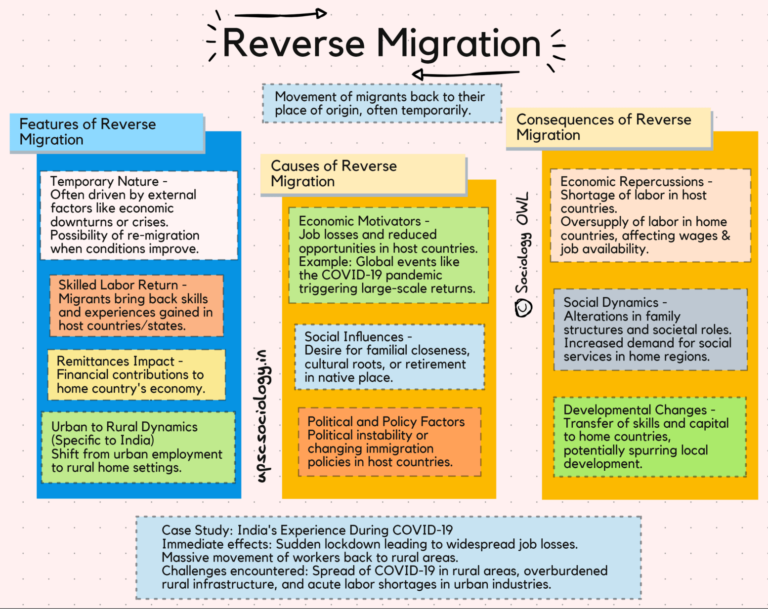Model Answers
Q: What is ‘reverse migration’ ? Discuss its features, causes and consequences in India.
Question asked in UPSC Sociology 2023 Paper 2. Download our app for last 20 year question with model answers.
Model Answer:
Reverse Migration Meaning
Reverse migration, also known as return migration, refers to the phenomenon where migrants return to their place of origin after having migrated to another place for a certain period. It’s a common occurrence worldwide, but it has gained significant attention in India due to the large-scale reverse migration prompted by the COVID-19 pandemic.
Features of Reverse Migration:
- Temporary Nature: Reverse migration is often temporary, with migrants returning to their home regions during periods of economic downturn or crisis and then re-migrating when conditions improve. (Example: Seasonal agricultural workers)
- Skilled Labor: Reverse migration often involves skilled laborers who have gained skills and experience in their host countries and bring these back to their home countries. (Example: Tech professionals returning home)
- Remittances: Reverse migrants often continue to send remittances to their families in their host countries, contributing to the economy of those countries. (Example: Overseas workers supporting families)
- Urban to Rural: In the India, reverse migration often involves movement from urban to rural areas. (Example: City workers returning village)
Causes of Reverse Migration:
- Economic Factors: Economic downturns or lack of job opportunities in host regions can prompt reverse migration. The COVID-19 pandemic, for example, led to widespread job losses, prompting many migrants to return to their home regions.
- Social Factors: Migrants may also return home due to social factors like family ties, cultural connections, or a desire to retire in their home country. (Example: Retirees returning to roots)
- Political Factors: Political instability or changes in immigration policies can also lead to reverse migration. (Example: Brexit-induced EU worker exodus)
Consequences of Reverse Migration:
- Economic Impact: Reverse migration can have a significant economic impact. It can lead to labor shortages in host regions and an oversupply of labor in home regions, potentially driving down wages. (Example: Construction sector labor gaps)
- Social Impact: Reverse migration can also have social impacts, such as changes in family structures and increased pressure on social services in home regions. (Example: Overcrowded rural healthcare facilities)
- Development Impact: On a positive note, reverse migration can contribute to development in home regions, as returning migrants bring skills, experience, and sometimes capital. (Example: Returnee-led rural startups)
Example of Reverse Migration in India:
A large-scale example of reverse migration in India occurred during the COVID-19 pandemic. With the nationwide lockdown, millions of migrant workers found themselves without work and means to survive in the cities. Consequently, they embarked on long journeys back to their home villages. This reverse migration posed significant challenges, including the risk of spreading the virus in rural areas, the strain on rural economies, and the potential disruption of urban economies due to labor shortages.
Conclusion:
Reverse migration is a complex phenomenon with significant economic, social, and development implications. It requires careful management and policy responses to mitigate its negative impacts and harness its potential benefits. In the Indian context, it highlights the need for stronger social protection for migrant workers and more balanced regional development to reduce the pressures for migration.
More Questions:
Download our app for UPSC Sociology Optional - Syllabus, NCERT Books, IGNOU Books, Past Paper with Model Answers, Topper Notes & Answer Sheet.



